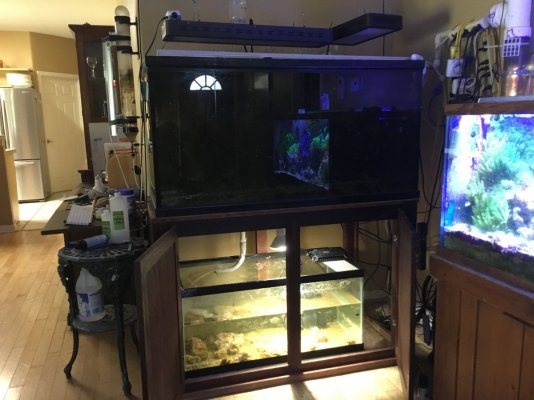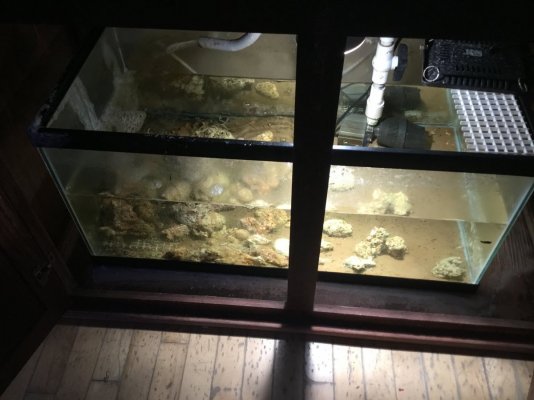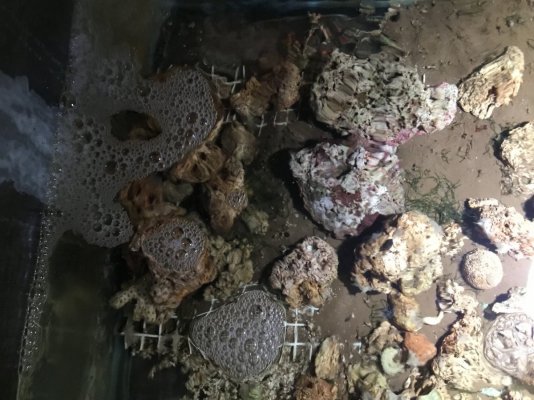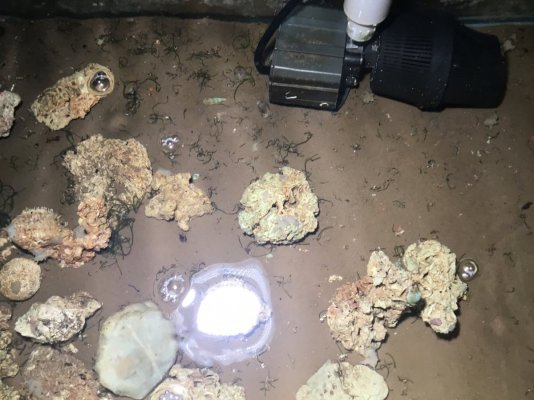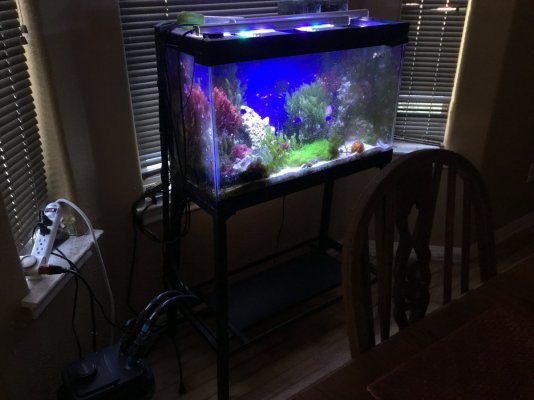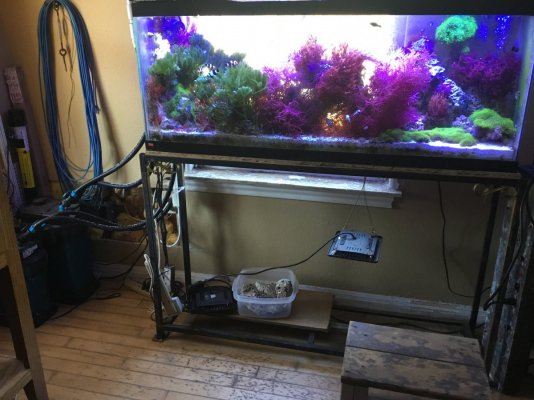Re: the OP - depends what we're trying to do and why we think a dsb will "solve" what problem.
(note I haven't read the paper cited by Randy, nor have I yet read in full subsea's post; they might cause me to modify my thinking.
The thread has also inspired me to reread https://chucksaddiction.thefishestate.net/seagrass.html)
Simplified, we are trying to keep a range of water parameters in our tanks, and control the growth of unwanted organisms - both within certain ranges. A life rock only tank, a soft coral tank, a mixed reef, and an acropora tank have a different range of desired parameters.
We can use any or all of the following methods.
1. microbiome management (stability in microorganisms prevents cycles of dinoflagellates, cyanobacteria, microalgae, etc.)
2. nitrification - the removal of ammonia, traditionally done in freshwater tanks and carried over into marine tanks, by bacterial conversion into nitrite, nitrate.
3. nutrient removal - by one or (more commonly) a combination of water changes, various media (e.g. active carbon, GFO), mechanisms (skimmer most famously in reefing; but also filter socks, ozone and UV among others), denitrification (denitrifying bacteria on various media, DSBs), growing other things and then removing them, or just having straight up areas for stuff to decay and be eaten (the not-too-often-used cryptic refugium).
I'd also add that "growing other things and then removing them" has a hiearchy, in that some things will grow faster and often trump other things. In my recollected order of what generally outcompetes other things:
- GHA (used as a filter in an algae turf scrubber, or unintentionally grown in the tank and hopefully exported by herbivores)
- chaeto (in a refugium or a chaeto reactor)
- most species of caulerpa and ulva (in reactor or fuge)
- gracillaria and other macro algae (reactor or fuge)
- merman's shaving brush, halimeda (more ornamental than anything else in our usage)
- Xenia (xenia fuges are a thing; some propose them as excellent ways to get rid of DOC)
- [I think seagrasses would go here]
- [mangroves would go here]
- [I assume other soft corals?]
- Acropora, Montipora, and otehr SPS [people have used this flippantly to emphasize the point that SPS use nutrients, which is why a tank with large and well established colonies can absorb lots of nutrients and be quite stable]
So amid all this, where do stand with DSBs and seagrass?
The DSB was meant to be a location for microfaunal stability and at the very least nitrogen absorbtion. That said, if you keep putting nutrients into it as basically a dumping ground, it seems to me (and sort of confirmed by my recollection of the controversy on DSBs) that it eventually becomes a composting area/landfill. [seafill?].
This is theoretically good for seagrass, but only to a certain point.
I'd also add that
- I'm now sure how well a seagrass refugium would work versus known mechanisms like an ATS (e.g. from Santa Monica Filtration), a macroalgae reactor or a macroalgae refugium.
- In nature, many photosynthetic seagrass beds (at least in an estuary or lagoon environment) face the direction of (i.e. absorb) riverborne nutrients coming into the sea. Though oftentimes some corals live among them - to include some kinds of LPS and softies! - they generally a good distance away from coral reefs proper, which generally have much more flow and lower amounts of nutrients.
(note that mesophotic seagrass beds are a completely different story, though IIRC there are ones that have both tracyphylia, deepwater seagrass and deepwater halimeda species)
I do hope someday to combine a display acro tank linked to a display seagrass refugium. (shallow lagoon seagrass!) But based on what I've heard I am concerned that the requirements (N/P/DOC levels, chemical warfare, nutrient import/export) for those to thrive would be divergent in a way that can't be resolved by having them in seperate connected tanks. (i.e. i fear that the heavy in and heavy out process and desired range of those parameters for acros might be too little for seagrass). I also fear that they will not be complimentary, but such a system might require at the very least heavy N and P supplementation.
In sum, I'm inclined to think seagrass is better as its own kind of biotope (marine planted tank?) tank vs a kind of refugium.
(note I haven't read the paper cited by Randy, nor have I yet read in full subsea's post; they might cause me to modify my thinking.
The thread has also inspired me to reread https://chucksaddiction.thefishestate.net/seagrass.html)
Simplified, we are trying to keep a range of water parameters in our tanks, and control the growth of unwanted organisms - both within certain ranges. A life rock only tank, a soft coral tank, a mixed reef, and an acropora tank have a different range of desired parameters.
We can use any or all of the following methods.
1. microbiome management (stability in microorganisms prevents cycles of dinoflagellates, cyanobacteria, microalgae, etc.)
2. nitrification - the removal of ammonia, traditionally done in freshwater tanks and carried over into marine tanks, by bacterial conversion into nitrite, nitrate.
3. nutrient removal - by one or (more commonly) a combination of water changes, various media (e.g. active carbon, GFO), mechanisms (skimmer most famously in reefing; but also filter socks, ozone and UV among others), denitrification (denitrifying bacteria on various media, DSBs), growing other things and then removing them, or just having straight up areas for stuff to decay and be eaten (the not-too-often-used cryptic refugium).
I'd also add that "growing other things and then removing them" has a hiearchy, in that some things will grow faster and often trump other things. In my recollected order of what generally outcompetes other things:
- GHA (used as a filter in an algae turf scrubber, or unintentionally grown in the tank and hopefully exported by herbivores)
- chaeto (in a refugium or a chaeto reactor)
- most species of caulerpa and ulva (in reactor or fuge)
- gracillaria and other macro algae (reactor or fuge)
- merman's shaving brush, halimeda (more ornamental than anything else in our usage)
- Xenia (xenia fuges are a thing; some propose them as excellent ways to get rid of DOC)
- [I think seagrasses would go here]
- [mangroves would go here]
- [I assume other soft corals?]
- Acropora, Montipora, and otehr SPS [people have used this flippantly to emphasize the point that SPS use nutrients, which is why a tank with large and well established colonies can absorb lots of nutrients and be quite stable]
So amid all this, where do stand with DSBs and seagrass?
The DSB was meant to be a location for microfaunal stability and at the very least nitrogen absorbtion. That said, if you keep putting nutrients into it as basically a dumping ground, it seems to me (and sort of confirmed by my recollection of the controversy on DSBs) that it eventually becomes a composting area/landfill. [seafill?].
This is theoretically good for seagrass, but only to a certain point.
I'd also add that
- I'm now sure how well a seagrass refugium would work versus known mechanisms like an ATS (e.g. from Santa Monica Filtration), a macroalgae reactor or a macroalgae refugium.
- In nature, many photosynthetic seagrass beds (at least in an estuary or lagoon environment) face the direction of (i.e. absorb) riverborne nutrients coming into the sea. Though oftentimes some corals live among them - to include some kinds of LPS and softies! - they generally a good distance away from coral reefs proper, which generally have much more flow and lower amounts of nutrients.
(note that mesophotic seagrass beds are a completely different story, though IIRC there are ones that have both tracyphylia, deepwater seagrass and deepwater halimeda species)
I do hope someday to combine a display acro tank linked to a display seagrass refugium. (shallow lagoon seagrass!) But based on what I've heard I am concerned that the requirements (N/P/DOC levels, chemical warfare, nutrient import/export) for those to thrive would be divergent in a way that can't be resolved by having them in seperate connected tanks. (i.e. i fear that the heavy in and heavy out process and desired range of those parameters for acros might be too little for seagrass). I also fear that they will not be complimentary, but such a system might require at the very least heavy N and P supplementation.
In sum, I'm inclined to think seagrass is better as its own kind of biotope (marine planted tank?) tank vs a kind of refugium.
Last edited:










